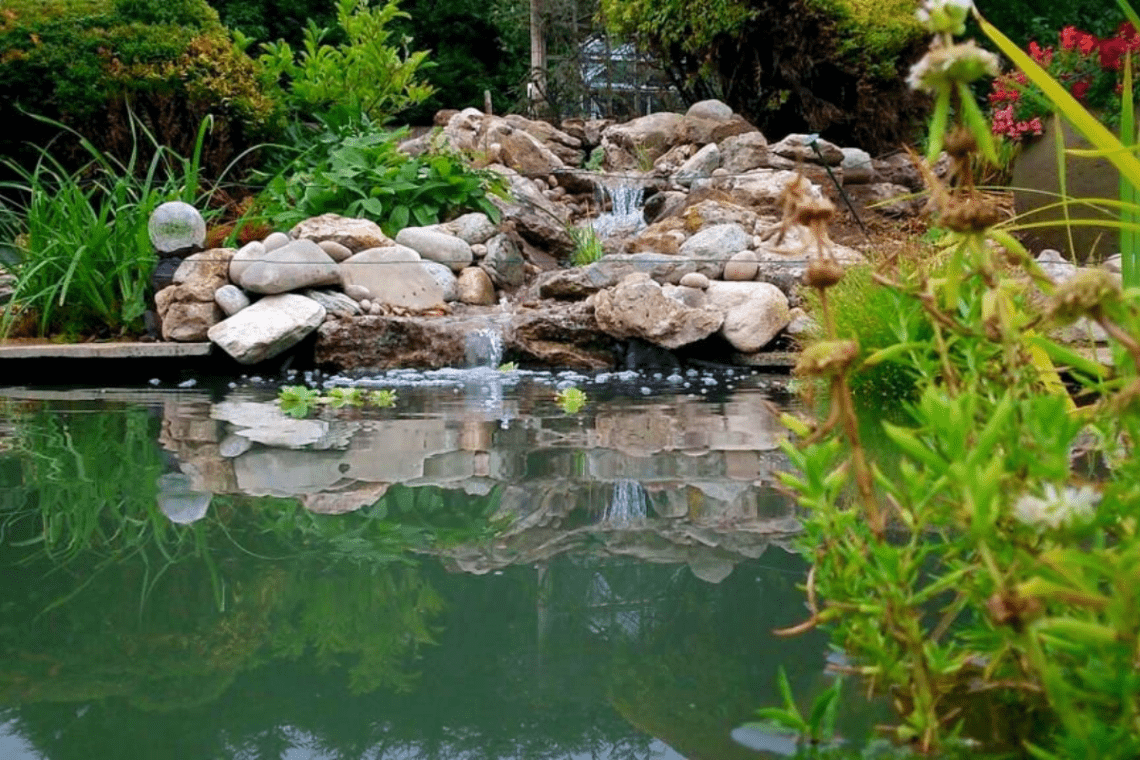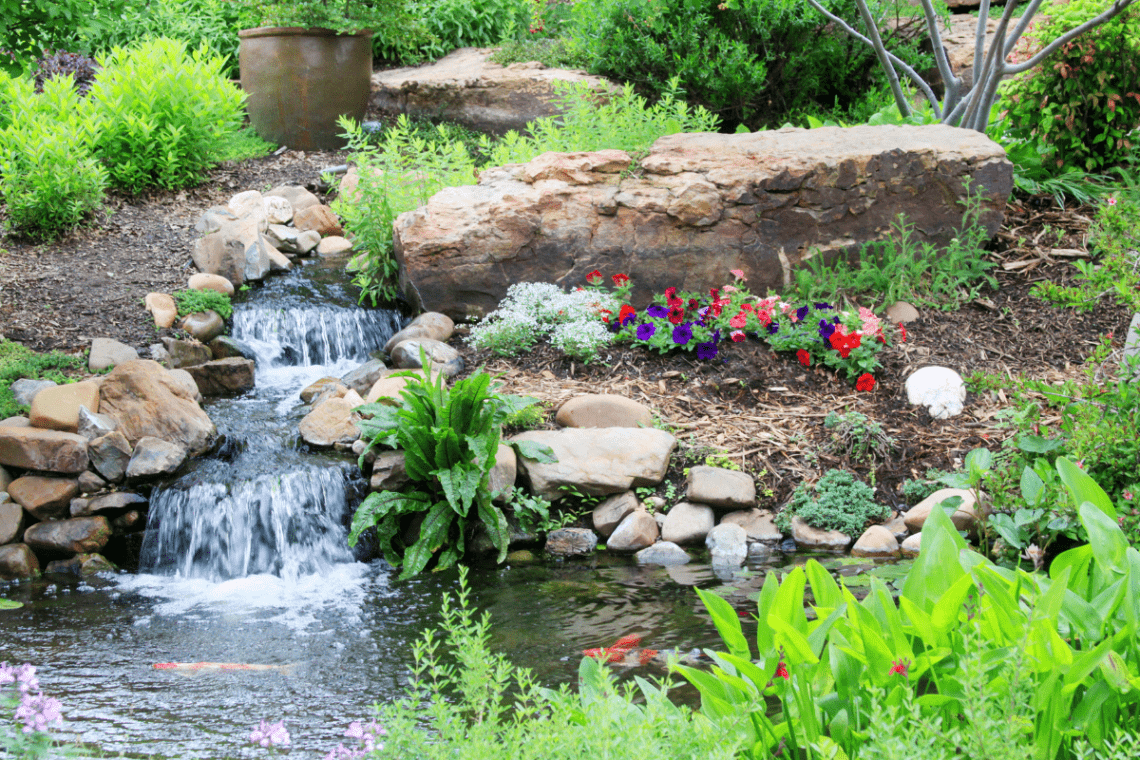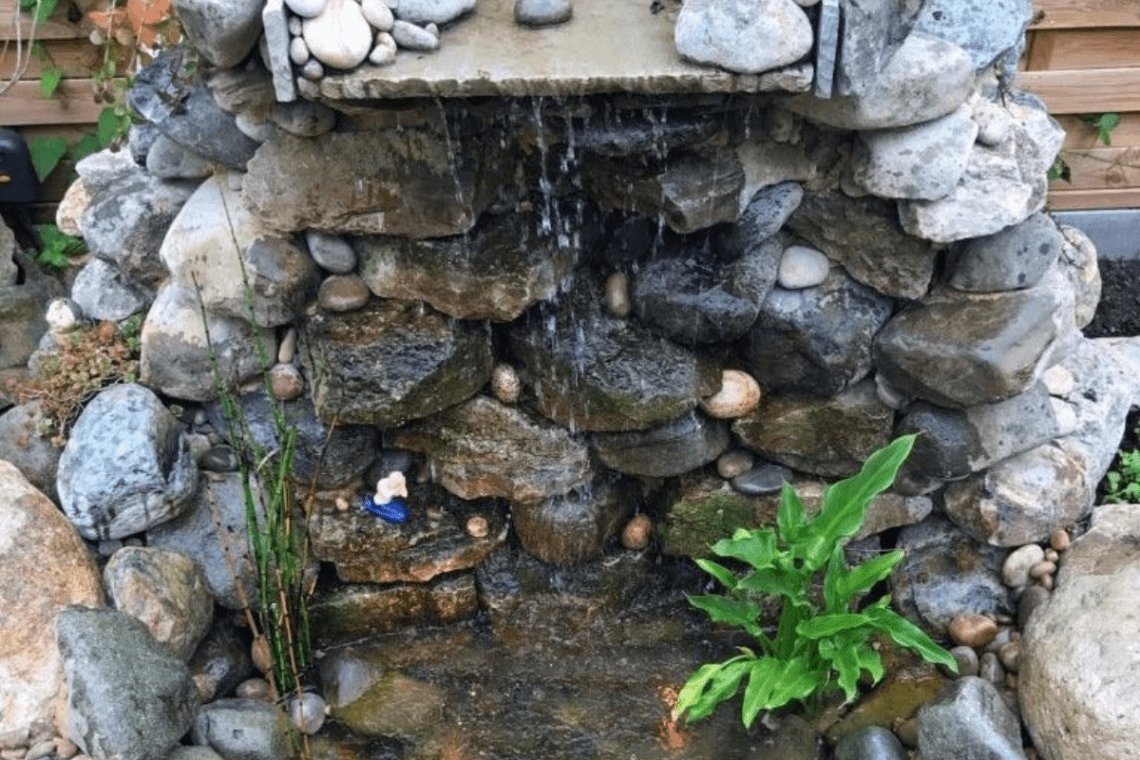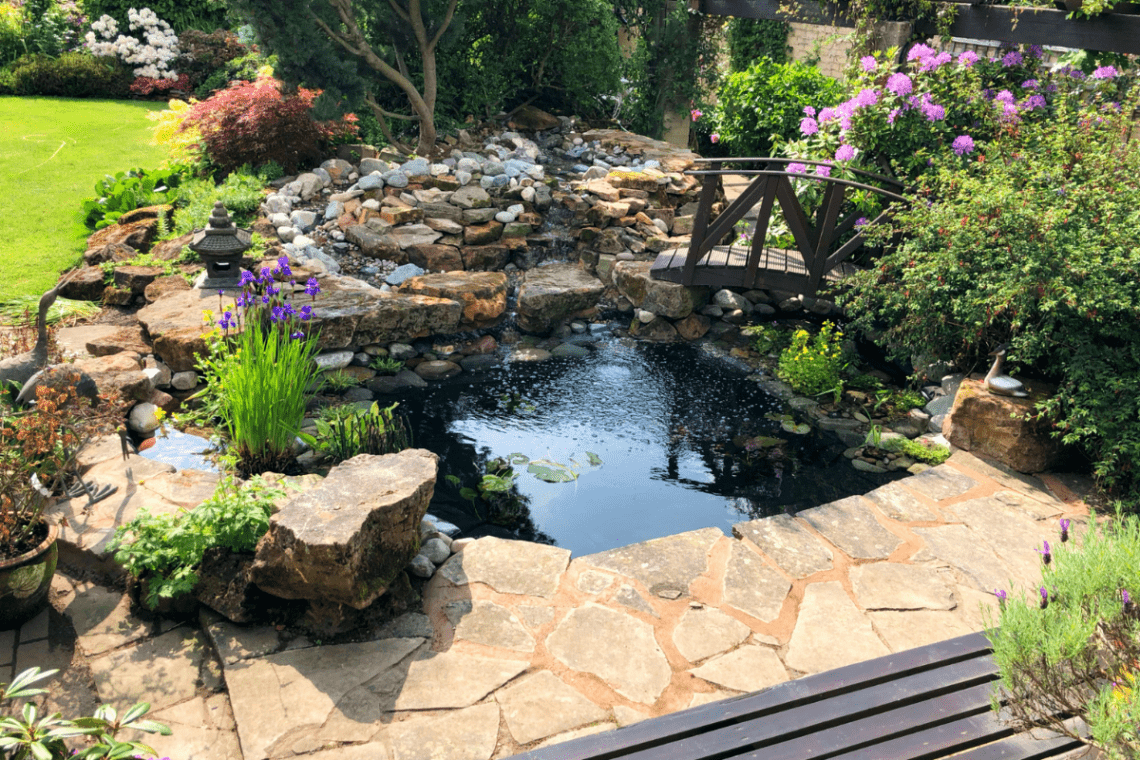Waterfalls are not just beautiful additions to garden ponds; they bring a multitude of benefits ranging from aesthetic enhancements to health improvements.
In this post, we’ll explore pond waterfall benefits and provide guidance on how to choose and maintain this enchanting feature.
What is a Waterfall?

A waterfall in a garden pond typically involves water being pumped from the pond into an elevated area, from which it cascades back down into the pond. The continuous movement of water provided by a waterfall contributes to the health and vitality of your pond, making it a focal point of beauty and biodiversity in your garden.
Enhancing Your Garden Ecosystem
Introducing a waterfall into a garden pond does more than just improve its visual appeal. The continuous movement of water helps to filter out impurities, reduce algae growth, and distribute nutrients evenly throughout the pond, which is beneficial for fish and plant health.
The continuous cycle of water movement created by a waterfall serves a crucial purpose: aeration. Aeration from waterfalls increases oxygen levels in the water, which is essential for the well-being of aquatic life. Fish, plants, and other pond inhabitants rely on oxygen to thrive, and adequate aeration ensures they have access to the oxygen they need to survive and flourish.
In addition to aeration, the movement of water created by the waterfall serves as a natural filtration system for the pond. As water cascades over rocks and surfaces, it mechanically removes debris and suspended particles, helping to circulate beneficial bacteria, clarify the water and maintain its quality.
Aesthetic Benefits

Waterfalls are a captivating feature in any garden, providing both visual and auditory beauty that can enhance the overall aesthetic of a landscape.
Visual Appeal
The dynamic presence of a waterfall can transform an ordinary garden into a serene haven. The visual effect of water flowing over rocks or down a carefully constructed spillway creates a focal point that draws the eye and becomes the centrepiece of the garden.
The continuous flow of water adds a sense of movement that enlivens a static garden environment. This movement not only attracts attention but also contributes to the overall balance of the landscape, integrating water, stone, and vegetation in a harmonious display.
Enhances Landscape Diversity
Incorporating a waterfall adds a rich layer of diversity to garden landscaping and is a vital component of a pond ecosystem:
- Varied plant opportunities: The moist environment near a waterfall supports a variety of plants that might not thrive in other parts of the water garden. Ferns, mosses, and water-loving pond plants can flourish, enhancing biodiversity and creating a lush, vibrant landscape.
- Habitat creation: Waterfalls may attract wildlife such as birds, butterflies, and amphibians, turning the garden into a lively habitat and contributing to local biodiversity.
Increases Property Value
A well-designed waterfall is more than just an aesthetic enhancement; it’s an investment in the property. Waterfalls are often associated with luxury, which can elevate the perceived value of the property. They signify a level of care and investment in the property that is attractive to buyers.
Homes with unique landscaping water features like waterfalls and ponds are often more appealing to potential buyers than those without. This curb appeal can translate into faster sales and potentially higher offers.
The Impact on Health and Wellness

Waterfalls are not only stunning visual elements in any garden pond but also serve significant health benefits, both mentally and physically.
Physical Health Improvements
The proximity to waterfalls enhances physical well-being through mechanisms that might seem almost magical but are deeply rooted in science.
- Negative ions: Waterfalls generate negative ions, which have several benefits for physical health. These ions improve air quality by neutralising airborne pollutants, pollen, and dust, which is particularly beneficial for people suffering from allergies or respiratory issues. Moreover, the increased oxygen flow to the brain can lead to higher alertness and decreased drowsiness, enhancing cognitive function throughout the day.
- Lower blood pressure: The relaxation induced by the sounds of a waterfall can lead to lower blood pressure. This is achieved through the calming effects on the nervous system, which helps to reduce heart rate and relax blood vessels.
- Air quality: Beyond their auditory benefits, waterfalls also impact the physical environment by increasing air humidity. This increased humidity is particularly beneficial for respiratory health, as it can help to moisten the airways and reduce the prevalence of irritants that can cause problems for individuals with respiratory conditions such as asthma.
Improved Relaxation and Mental Health
The soothing sound of flowing water from a waterfall is inherently calming and can greatly reduce stress levels. This makes waterfalls not just a visual enhancement but a therapeutic addition to garden ponds.
- Sound therapy: The gentle, consistent sound of water cascading down a waterfall acts as natural white noise, which can mask distracting sounds and noise pollution. This acoustic water feature helps to reduce stress and anxiety, promoting a sense of calm and focus.
- Enhanced mood: The presence of negative ions can also improve mental health, mood and overall feelings of well-being. Research suggests that negative ions help elevate serotonin levels, a key hormone that stabilises mood, feelings of well-being, and happiness.
Incorporating garden pond waterfalls not only enriches the aesthetic appeal but serves as a continuous source of natural therapy, enhancing the quality of life for all who spend time in its presence.
How to Incorporate a Waterfall in Your Pond

Adding a waterfall to your garden pond is a transformative project that enhances both the beauty and ambiance of your outdoor space. Choosing the right type of waterfall and maintaining it properly are essential steps to ensure its longevity and functionality.
Choosing the Right Type of Waterfall
Making a choice from waterfall design ideas depends on the size of your pond, the surrounding landscape, and your personal aesthetic preferences:
- Cascade: This style is ideal for creating a dramatic visual impact. Cascade waterfalls feature large, tiered drops where water descends over multiple levels of rocks or other materials. They are perfect for larger ponds and can be designed to look like a natural mountain waterfall, adding a dynamic and majestic element to the garden.
- Stream: For those seeking a more subtle enhancement, a stream-style waterfall is a perfect choice. This type mimics the natural look and gentle flow of a stream, winding its way through the garden before entering the pond. It’s excellent for creating a tranquil and peaceful environment, suitable for a meditation or relaxing area in your garden.
- Spillway: If your pond is relatively small or you prefer a minimalist design, a spillway might be the best option. This type of waterfall uses a simple ledge or lip from which water spills directly into the pond below, creating a smooth, curtain-like effect. Spillways are elegant and understated, providing the soothing sound of water without requiring the space needed for larger, more complex designs.
Maintenance Tips
To ensure your waterfall remains beautiful and functional, regular maintenance is essential:
- Keep it clean: Regularly remove leaves and debris to prevent blockages.
- Check water levels: Ensure adequate water levels to prevent water pump damage.
- Winter care: Take steps to protect your waterfall and winterise your pond to avoid freezing damage.
Have a look at our pond maintenance packages and let us do the hard work for you.
How to Build a Waterfall in a Garden Pond
Here’s a simple guide to get you started:
- Plan: Decide where you want your waterfall and gather your materials.
- Dig: Dig a shallow trench where your waterfall will flow into the pond.
- Line: Use a pond liner to cover the trench and keep water from leaking.
- Place Rocks: Arrange rocks in the trench to create the waterfall shape.
- Install Pump: Place a water pump at the bottom to pump water to the top.
- Test: Fill your pond with water and check if the waterfall works properly.
- Finishing Touches: Once everything’s working, add any final touches like plants or lights.
Transform Your Garden with a Waterfall

Incorporating a waterfall into your garden pond is not just about enhancing its beauty; it’s about creating a space that promotes relaxation, improves health, and increases the value of your property.
At Ponds by Michael Wheat, we specialise in bringing these naturalistic elements into your outdoor spaces, from swimming ponds to koi ponds. Our expertise ensures that every waterfall we design is a perfect blend of form and function, tailored to enhance your unique landscape and meet your aesthetic and practical needs.
Are you ready to transform your garden into a backyard oasis with a stunning waterfall? Contact us today to start your journey towards a more peaceful and picturesque garden.